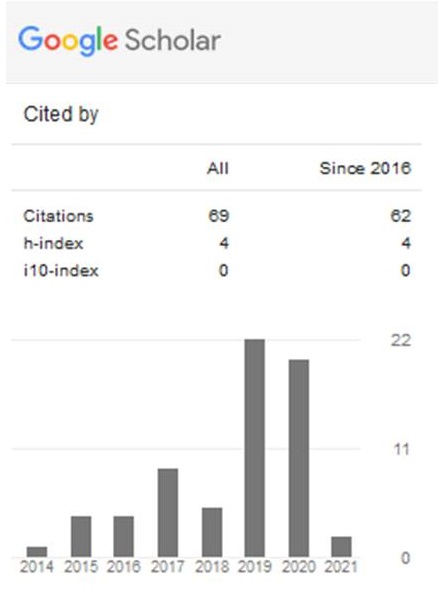Optimalisasi Produksi Kelapa Sawit (Elaeis guineensis Jacq.) melalui Pengaturan Jumlah Pelepah dan Aplikasi Pupuk Kalium
Abstract
Keywords
Full Text:
PDF (Bahasa Indonesia)References
Abdullah, S. N. A., A. M. Azzeme, M. Ebrahimi, E. A. K. E. Ariff, dan F. H. A. Hanifiah. 2017. Transcription Factors Associated with Abiotic Stress and Fruit Development in Oil Palm. In Crop Improvement. Springer, Cham.
Ajambang, W., S. W. Ardie, H. Volkaert, M. Galdima, and S. Sudarsono. 2015. Huge carbohydrate assimilates delay response to complete defoliation stress in oil palm (Elaeis guineensis Jacq.). Emirates Journal of Food and Agriculture. 27(1), 127-138.
Awal, M. A., W. I. W Ismail., M. H. Harun, dan J. Enda. 2005. Methodology and measurement of radiation interception by quantum sensor of the oil palm plantation. Songklanakarin Journal of Science and Technology. 27(5): 1083- 1093.
Badan Pusat Statistik. 2021. Riau dalam Angka 2020. Badan Pusat Statistik. Pekanbaru.
Bata, Y., Rahayu, E., dan Andayani, N. 2016. Produktivitas Kelapa Sawit yang Dipupuk dengan Tandan Kosong Kelapa Sawit. Jurnal Agromast, 1(2).
Direktorat Jenderal Perkebunan. 2021. Statistik Perkebunan Indonesia. Direktorat Jenderal Perkebunan. Jakarta.
Edison, R dan Ridwan. B. 2016. Pemanfaatan Tangkai Pelepah Kelapa Sawit sebagai Bahan Baku Asap Cair untuk Penggumpalan Lateks. Prosiding Seminar Nasional Pengembangan Teknologi Pertanian. Hal: 87-94. ISBN: 978-602- 70530-4-45.
Elgani, H.A.R 2013. Manajemen Penunasan Kelapa Sawit (Elaeis guineensis Jacq.) Di Sungai Bahaur Estate, PT Windu Nabatindo Abadi, Kalimantan Tengah. Skripsi (Tidak dipublikasikan). Institut Pertanian Bogor. Bogor.
Fauzi, Y., Widyastuty, Y., E. Setyawibawa, I., Hartono, R. 2007. Kelapa Sawit. Penebar Swadaya. Jakarta.
Gromikora, N., S. Yahya, dan Suwarto. 2014. Permodelan pertumbuhan dan produksi kelapa sawit pada berbagai taraf penunasan. Jurnal Agron Indonesia. 42(3): 228- 235.
Halpera, H dan S. Subagiono. 2018. Pengaruh pemberian dosis KCL terhadap pertumbuhan dan hasil tanaman kelapa sawit (Elaeis guineensis Jacq.) TM 15 di ultisol Kabupaten Bungo. Jurnal Sains Agro. 3(2): 1- 11.
Haminin, H., T. Nugrahini, dan P. Purwati. 2012. Pengaruh penunasan dan pemberian pupuk NPK phonska terhadap produksi tanaman kelapa sawit (Elaeis guineensis Jacq.). Jurnal Ilmu Pertanian. 1(2): 49- 54.
Hanafiah, K. A. 2010. Dasar- Dasar Ilmu Tanah. Rajawali Press. Jakarta.
Harahap I.Y. 2006. Penataan ruang pertanaman kelapa sawit berdasar pada konsep optimalisasi pemanfaatan cahaya matahari. WARTA PPKS.Vol 14(1): 9-15
Harahap IY, Edy SS, Roletha YP, dan Nuzul HD. 2005. Peran Pemupukkan terhadap Pertumbuhan dan Kesehatan Bibit Kelapa Sawit. Yogyakarta.
Harahap IY. 2008. Kajian diferensiasi jenis kelamin pada pembentukan bunga kelapa sawit (Elaeis guineensis Jacq.) melalui pendekatan kuantitatif statistik. Jurnal Penelitian Kelapa Sawit. 16(1):47–54.
Hassan H., Amiruddin MD, Weckwerth W, dan Ramli US. 2019. Deciphering Key Proteins of Oil Palm (Elaeis guineensis Jacq.) Fruit Mesocarp Development by Proteomics and Chemometrics. Electrophoresis. 40(2): 254-265.
Henson, I.E., M.T. Dolmat. 2003. Physiological analysis of an oil palm density trial on a peat soil. J. Oil Palm Res. 15:1-27.
Hoffmann, M. P., Vera, A. C., Wijk, V. M. T., Giller, K. E., Oberthur, T., Donough, C., dan Whitbread, A. M. 2014. Simulating potensial growth and yield of oil palm (Elaeis guineensis Jacq.) with palmsim: model description, evaluation, and application. Agricultural Systems, 131, 1-10
Idris, I., Mayerni, R., dan Warnita, W. 2020. Karakterisasi Morfologi Tanaman Kelapa Sawit (Elaeis guineensis Jacq.) Di Kebun Binaan Ppks Kabupaten Dharmasraya. Journal of Plantation Research, 1(1), 45-53.
Imogie, A. E., P. O. Oviasogie., B. O. Ejedegba, dan C. V. U. 2012. Effect of potassium (K) source on oil palm yield at Okomu oil palm plc, Ovia North East L. G. A of Edo State. International Journal of Plant Research. 2(1): 35- 38.
Jazayeri, S. M., Y. D. Rivera, J. E. Camperos-Reyes, dan H. M. Romero. 2015. Efectos fisiologicos del deficit hidrico en dos genotipos de palma de aceite (Elaeis guineensis Jacq.). Agronomia Colombiana, 33(2), 164-173
Jumin, Hasan Basri. 2014. Agonomi. Raja Grafindo Persada. Jakarta. Hal 7- 17.
Junaedi, D. 2019. Perilaku Petani terhadap Pengelolaan Pelepah pada Tanaman Kelapa Sawit (Elaeis guineensis Jacq.) di Kecamatan Sirapit Kabupaten Langkat. Tugas Akhir (Tidak dipublikasikan). Politeknik Pembangunan Pertanian Medan. Medan.
Khoiri, M. A., Hamdani, J. S., Suherman, C., dan Ruminta, R. 2018. Efek Pemangkasan Akar Dan Pemangkasan Pelepah Terhadap Pertumbuhan Akar dan Bunga Kelapa Sawit (Elaeis guineensis Jacq.). Prosiding seminar nasional bidang ilmu-ilmu pertanian.
Khoiri, M. A., Hamdani, J. S., Suherman, C., dan Ruminta, R. 2020. Efek Pemangkasan Akar Dan Pemangkasan Pelepah Terhadap Kualitas Hasil Minyak Kelapa Sawit (Elaeis guineensis Jacq.) Pada Umur Yang Berbeda. Jurnal Agroekoteknologi, 12(2), 192-203.
Lakitan, B. 2013. Fisiologi Tumbuhan dan Perkembangan Tanaman. Raja Grafindo Persada. Jakarta.
Legros, S., I. Mialet-Serra, J. P. Caliman, F. A. Siregar, A. Clement-Vidal, D. Fabre, and M. Dingkuhn. 2009. Phenology, growth, and physiological adjustments of oil palm (Elaeis guineensis Jacq.) to sink limitation induced by fruit pruning. Annals of Botany, 104(6), 1183-1194.
Marcelino, J.P., and Diaz, E.V. 2016. Frond Pruning Enhanced the Growth and Yield of Eight-Year-Old Oil Palm (Elaeis guineensis Jacq.). Annals of Tropical Research. 38(2): 96-105.
Nanik, A. S., M. Kosuke, dan S. Ahyahudin. 2020. The effect of water deficit on inflorescence period at palm oil productivity on peatland. E3S Web of Conferences, 211, 2–11.
Pahan, I. 2008. Kelapa Sawit Manajemen Agribisnis dari Hulu hingga Hilir. Penebar Swadaya. Jakarta.
Pahan, I. 2012. Panduan Lengkap Kelapa Sawit Manajemen Agribisnis dari Hulu hingga Hilir. Penebar Swadaya. Jakarta.
Pambudi, I. H. T., Suwarto, dan Y. Sudirman. 2016. Pengaturan jumlah pelepah untuk kapasitas produksi optimum kelapa sawit (Elaeis guineensis Jacq.). Buletin Agrohorti. 4(1): 46- 55.
Refbacks
- There are currently no refbacks.

_2017.jpg)



